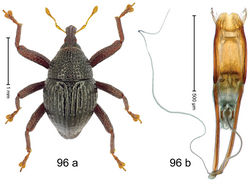Trigonopterus tenuipes
| Notice: | This page is derived from the original publication listed below, whose author(s) should always be credited. Further contributors may edit and improve the content of this page and, consequently, need to be credited as well (see page history). Any assessment of factual correctness requires a careful review of the original article as well as of subsequent contributions.
If you are uncertain whether your planned contribution is correct or not, we suggest that you use the associated discussion page instead of editing the page directly. This page should be cited as follows (rationale):
Citation formats to copy and paste
BibTeX: @article{Riedel2019ZooKeys, RIS/ Endnote: TY - JOUR Wikipedia/ Citizendium: <ref name="Riedel2019ZooKeys">{{Citation See also the citation download page at the journal. |
Ordo: Coleoptera
Familia: Curculionidae
Genus: Trigonopterus
Name
Trigonopterus tenuipes Riedel sp. n. – Wikispecies link – ZooBank link – Pensoft Profile
Diagnostic description
Holotype, male (Fig. 96a). Length 2.00 mm. Color of antennae yellowish; legs and rostrum dark ferruginous; remainder black. Body subovate; in dorsal aspect with weak constriction, in profile with distinct constriction between pronotum and elytron. Rostrum long; at basal 1/3 with constriction; dorsally with median costa and pair of submedian ridges; intervening furrows with rows of punctures containing each one indistinct seta; epistome indistinct, with median ridge. Pronotum with disk densely, coarsely punctate; interspaces between punctures reticulate, subglabrous. Elytra coriaceous, striae deeply impressed, dorsally intervals costate; sutural interval basally curving laterad; laterally striae marked by rows of coarse punctures. Legs long. Profemur with anteroventral ridge simple; meso- and metafemur with indistinct denticle in apical 1/3; anterior surface of femora coarsely punctate, reticulate, weakly microreticulate. Metafemur subapically with stridulatory patch. Abdominal ventrite 1 microreticulate, concave, at middle with coarse punctures; ventrite 5 microreticulate, with shallow concavity, laterally weakly rugose. Penis (Fig. 96b) with sides subparallel, in apical 1/3 weakly converging; subapically with lateral fringes of setae; subtruncate apex nude, with median notch; apodemes 1.3 × as long as body of penis; transfer apparatus short spiniform, directed basad in repose; ductus ejaculatorius with indistinct bulbus. Intraspecific variation. Length 2.00–2.22 mm. Female rostrum with lateral and sublateral rows of punctures, medially with glabrous costa.
Material examined
Holotype (MZB): ARC2761 (GenBank # MK260323), N-Sulawesi Prov., Tomohon, Rurukan, Gn. Mahawu, 01°20.844'N 124°52.253'E to 01°20.751'N 124°52.129'E, 1209–1305 m, beaten, 15-V-2012. Paratypes (MZB, SMNK): N-Sulawesi Prov.: 3 exx, ARC2758 (GenBank # MK260325), ARC2759 (GenBank # MK260324), Tomohon, Rurukan, Gn. Mahawu, 01°21.409'N 124°51.535'E to 01°21.370'N 124°51.676'E, 1126–1231 m, beaten, 14-V-2012.
Distribution
N-Sulawesi Prov. (Tomohon). Elevation ca. 1130–1210 m.
Biology
On foliage in montane forests.
Etymology
This epithet is a combination of the Latin adjective tenuis, -e (thin) and the noun pes (foot, leg). It refers to the species´ long, slender legs.
Notes
Trigonopterus tenuipes Riedel, sp. n. was coded as “Trigonopterus sp. 405”.
Original Description
- Riedel, A; Narakusumo, R; 2019: One hundred and three new species of Trigonopterus weevils from Sulawesi ZooKeys, (828): 1-153. doi
Images
|
